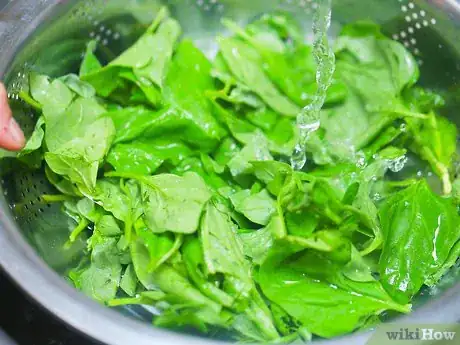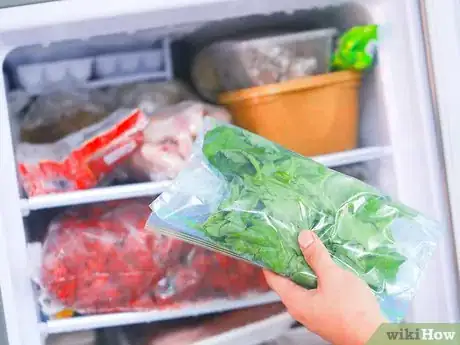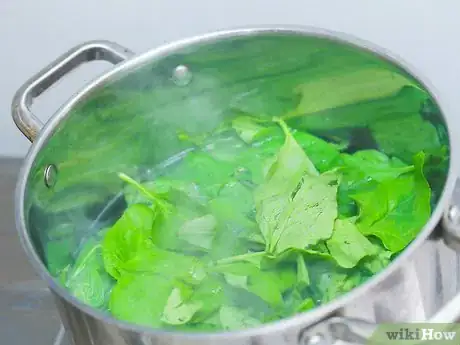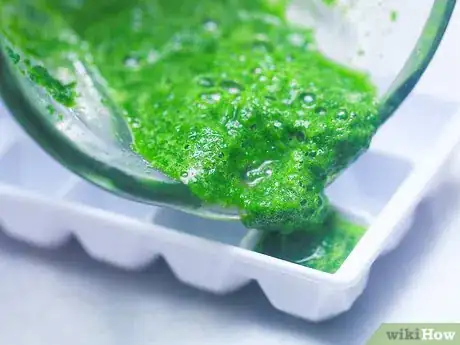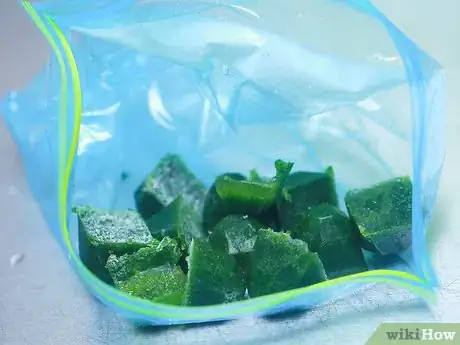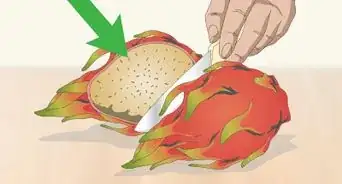This article was co-authored by wikiHow staff writer, Amy Bobinger. Amy Bobinger has been a writer and editor at wikiHow since 2017. She especially enjoys writing articles that help people overcome interpersonal hurdles but frequently covers a variety of subjects, including health and wellness, spirituality, gardening, and more. Amy graduated with a B.A. in English Lit from Mississippi College in 2011 and now lives in her hometown with her husband and two young sons.
The wikiHow Video Team also followed the article's instructions and verified that they work.
This article has been viewed 315,794 times.
Learn more...
Spinach typically becomes soft and mushy after you freeze it, but since it retains its nutrients and taste, frozen spinach can be great when added to smoothies and cooked dishes. Blanching spinach allows it to remain edible for longer periods, but you can also freeze unblanched spinach. Consider freezing pureed spinach if you wish to use it exclusively for liquid dishes later on.
Steps
Cleaning Spinach
-
1Soak the spinach in cool water. Place fresh spinach leaves into a large bowl, then cover them with clean, cold water.
- Use your hands to mix and sort through the spinach leaves as they soak. Sort through the leaves to remove damaged leaves, weeds, insects, stones, dirt, or other debris.
-
2Rinse well. Drain the soak water and transfer the spinach to a large colander. Rinse the spinach under cool, running water for about 30 seconds.
- If you're thorough enough, the first soak and rinse will probably remove most debris. For spinach that seems especially dirty, or to be extra cautious, repeat both steps twice more to remove as much dirt as possible.
Advertisement -
3Dry thoroughly. Place the spinach into a salad spinner, then use the utensil to spin away as much water as possible.
- If you do not have a salad spinner, you can wrap the leaves in paper towels and gently squeeze out the excess moisture. Afterward, spread the leaves out over a layer of fresh paper towels for 10 to 15 minutes to continue drying them.
- Thorough drying is especially important if you plan on freezing raw, unblanched spinach. It's not too significant when freezing blanched or pureed spinach, though.
Unblanched
-
1Pack the spinach in freezer-safe bags. Fill one or more freezer-safe plastic bags with as much clean spinach as possible. Squeeze out any excess air, then seal the bags.[1]
- Don't be afraid of packing the spinach too tightly. Tight packing is actually recommended since it leaves less room for excess air.
- You could also use freezer-safe plastic storage bins, but these do not work quite as well since you won't be able to remove quite as much excess air from the container prior to sealing it.
-
2Store the spinach in your freezer. Place the spinach in your freezer. It should remain edible for around six months.
- When you're ready to use it, thaw the spinach in your refrigerator for several hours. Squeeze any excess moisture out of the thawed leaves before using or consuming them.
- The cell membranes will break down during frozen storage, making thawed spinach too soft to eat raw, but you can still add it to smoothies and cooked recipes.
Blanched
-
1Boil water. Fill a large stockpot with enough cool water to cover the spinach, then set it on the stove over medium-high heat. Allow the water to reach a steady, rolling boil.
- Note that traditional blanching will preserve the color and taste of the spinach but may cause a loss of some nutrients to occur. To reduce the amount of nutrients lost, consider steam-blanching instead. Prepare to steam-blanch by placing a steaming basket over the boiling water.[2]
-
2Blanch the spinach for 2 minutes. Quickly dunk the full batch of spinach in the water and cover the stockpot. Start watching the clock immediately, and remove it after two minutes pass.[3]
- If steam-blanching the spinach, place the leaves in the steamer basket and immediately cover it with the lid. A tightly sealed lid is necessary to capture enough steam to blanch the spinach.
- If direct blanching the spinach, note that the water will likely turn green as it cooks.
-
3Transfer the leaves to ice water. Scoop the spinach out of the stockpot and into a large bowl filled with ice water. Keep the spinach submerged for another two minutes in this cold water.
- The quick transfer should stop the cooking process and halt the loss of nutrients. It should also further preserve the color and flavor of the spinach.
-
4Dry the spinach. Place the spinach in a salad spinner, then turn the spinner until the leaves seem dry.
- If you do not have a salad spinner, place the spinach leaves in a large colander set out over dry paper towels. Allow the spinach to drain for around 20 minutes, then use additional paper towels to tap away any excess moisture.
-
5Stuff the spinach into freezer-safe bags. Pack the prepared spinach into freezer-safe plastic bags. Squeeze or suck as much air from the bags as possible before sealing them.
- While you can technically use freezer-safe plastic containers instead of bags, doing so increases the risk of freezer burn since you won't be able to remove the excess air.
-
6Store the spinach in your freezer. Place the bags of spinach in your freezer for long-term storage. When prepared properly, blanched, frozen spinach should remain edible for around 9 to 14 months.
- Thaw the frozen spinach in your refrigerator for several hours prior to use. Since thawed spinach tends to be soggy, it cannot be eaten raw but can be used in smoothies and cooked dishes.
Pureed
-
1Blend together spinach and water. Combine six parts spinach and one part water in a standard blender. Cover and process the blender until the spinach breaks down into a smooth, thick puree.[4]
- For many blenders, you may need to avoid filling the blender more than halfway to allow the blades adequate access to its contents.
- You only need to add enough water to get the blender going. If your blender has a difficult time with the amount of water originally used, feel free to add more water in small increments.
-
2Pour the puree into molds. Once smooth, pour the puree into clean ice cube trays or similar molds. Fill each compartment within 1/4 inch (6 mm) of the top.
- If you don't have any spare ice cube trays, consider using mini muffin trays, standard muffin trays, or candy molds.
- Silicone trays and molds work especially well, but plastic versions can also be used.
-
3Freeze solid. Place the filled trays in your freezer for around four hours, or until the spinach puree is frozen solid.
-
4Transfer the solid puree to freezer-safe bags. Pop the frozen cubes of spinach out of their trays, then pack them into freezer-safe plastic bags. Remove excess air from the bags before sealing them.
- If you have difficulty removing the cubes from their trays, allow them to thaw at room temperature for several minutes. Try again once the sides and bottoms have softened, but before the cubes melt.
-
5Freeze as needed. Place the bags of frozen spinach puree back into the freezer. Store them for up to one year.
- You can thaw frozen spinach puree before use or add them to smoothies, stews, and similar dishes while they're still frozen solid.
Community Q&A
-
QuestionFor puree do you need to blanch first or leave it raw?
 Community AnswerBlanch it first. Spinach is very delicate, and while most enzymatic action causing damage is stopped at -18*c (your freezer temperature), not all is prevented. The spinach will last longer this way.
Community AnswerBlanch it first. Spinach is very delicate, and while most enzymatic action causing damage is stopped at -18*c (your freezer temperature), not all is prevented. The spinach will last longer this way. -
QuestionIs freezing spinach without blanching it a good idea?
 Community AnswerYou can freeze spinach without blanching it; however, it is recommended that you blanch for 2 minutes if you are going to keep the spinach in the freezer for more than 6 months.
Community AnswerYou can freeze spinach without blanching it; however, it is recommended that you blanch for 2 minutes if you are going to keep the spinach in the freezer for more than 6 months. -
QuestionDo you need to take stem off?
 Maggie PetersonCommunity AnswerIf the stems are long, then yes, the stems should be removed prior to freezing.
Maggie PetersonCommunity AnswerIf the stems are long, then yes, the stems should be removed prior to freezing.
Things You'll Need
Cleaning
- Large bowl
- Sink
- Colander
- Paper towels
- Salad spinner (optional)
Unblanched
- Freezer-safe plastic bags
Blanched
- Large stockpot
- Steamer basket (optional)
- Large mixing bowl
- Salad spinner OR colander
- Paper towels
- Freezer-safe plastic bags
Pureed
- Blender
- Ice cube trays OR similar molds
- Freezer-safe plastic bags
References
About This Article
To freeze spinach, blanch it first if you want it to last for around a year, or freeze it without blanching it if you'll use it within 6 months. When you're ready to freeze your spinach, put it into a sealable freezer bag and squeeze out the excess air with your hands. Then, store the spinach in your freezer. When you're ready to use it again, thaw it in the fridge for several hours and squeeze out any excess moisture in the leaves. To learn how to freeze pureed spinach, scroll down!
To freeze spinach, blanch it first if you want it to last for around a year, or freeze it without blanching it if you'll use it within 6 months. When you're ready to freeze your spinach, put it into a sealable freezer bag and squeeze out the excess air with your hands. Then, store the spinach in your freezer. When you're ready to use it again, thaw it in the fridge for several hours and squeeze out any excess moisture in the leaves. To learn how to freeze pureed spinach, scroll down!

